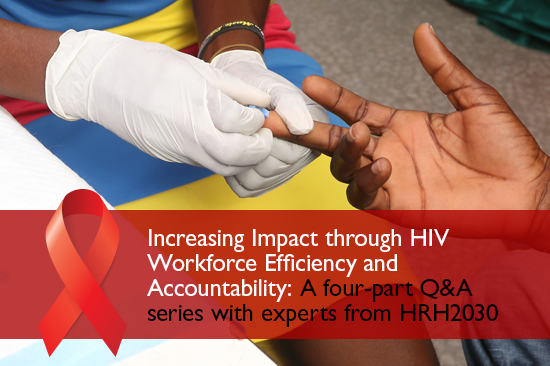
06 Dec AIDS Day Q&A Part 2: Optimizing the Role of Community-Based Workers in HIV Service Delivery
 René Berger is a director in the global health division of Chemonics. He has more than 17 years of experience working with USAID and implementing partners as an HIV/AIDS expert. Mr. Berger has been involved with PEPFAR since its inception and brings a strong understanding of the process and expectations of the initiative from both the Washington and field perspective.
René Berger is a director in the global health division of Chemonics. He has more than 17 years of experience working with USAID and implementing partners as an HIV/AIDS expert. Mr. Berger has been involved with PEPFAR since its inception and brings a strong understanding of the process and expectations of the initiative from both the Washington and field perspective.
What is the importance of the community-based workforce for delivery of HIV services, and how can this workforce be further leveraged to advance HIV goals?
Community-based workers play a number of key roles in supporting our effort to achieve epidemic control. Across the entire continuum — from identifying infected individuals, to linking them to treatment, and ensuring that they remain adherent to medications — community-based workers play an essential identification, linking, and motivating role. PEPFAR and USAID have seen the value of community-based workers. They assist in rolling out models of differentiated care. They also help to decongest healthcare facilities of patients who do not need to see a clinician or other type of provider. Community-based workers may also lead or support community groups that facilitate the distribution of anti-retrovirals. I strongly believe it will be the support that comes from the community that will help us reach the final milestone of viral suppression.
One of the many benefits of community-based workers is they are from the community and, therefore, know the community. They know who has been sick and when they’ve linked them with HIV care and treatment. They know who is receiving treatment for HIV and can help ensure that those individuals continue to take their medication and receive the follow-up care they may require. Ultimately, we may find that these community-based workers are also helping us defeat the stigma around HIV by showing the human side of HIV care.
What work is HRH2030 currently doing to support the community-based workforce?
HRH2030 is supporting a number of activities to assess the community-based workforce for USAID. In Uganda, we are working to build a model to identify the human resource needs around providing differentiated care. Two of the four common models are community-based — these are community-led groups overseeing HIV treatment (mostly refills for medications) and individual pharmacy distribution points based in the community. These too may be overseen by a community-based worker.
In South Africa and Zambia we are also doing assessments of the community-based workforce to identify who they are working with, what services they are providing, where they are providing services, how long it takes to provide the services, and how much they are compensated. The goal of these assessments is to identify efficiencies — for both the services being provided and the compensation that the community-based workers receive.
How can community-based workers impact national efforts to control the HIV epidemic, especially long-term?
Community-based workers have an important role to play if we are going to achieve the UNAIDS 90-90-90 goals. Whether it’s identifying new patients who require treatment or ensuring that someone who has been receiving anti-retrovirals for years continues to take their medication, these community-based personnel will be invaluable. They are really the eyes and ears on the ground and the ones who will be able to best say whether we are achieving the ambitious goals we’ve set out to achieve control of this epidemic.
Others in this Series
Part 1: Increasing HIV Impact through Human Resources for Health Interventions
Part 2: Optimizing the Role of Community-Based Workers in HIV Service Delivery
Part 3: Standardized Use of Site-Level HRH Data for Differentiated Models of ART Delivery
Part 4: Making the Case for Investing in HRH





